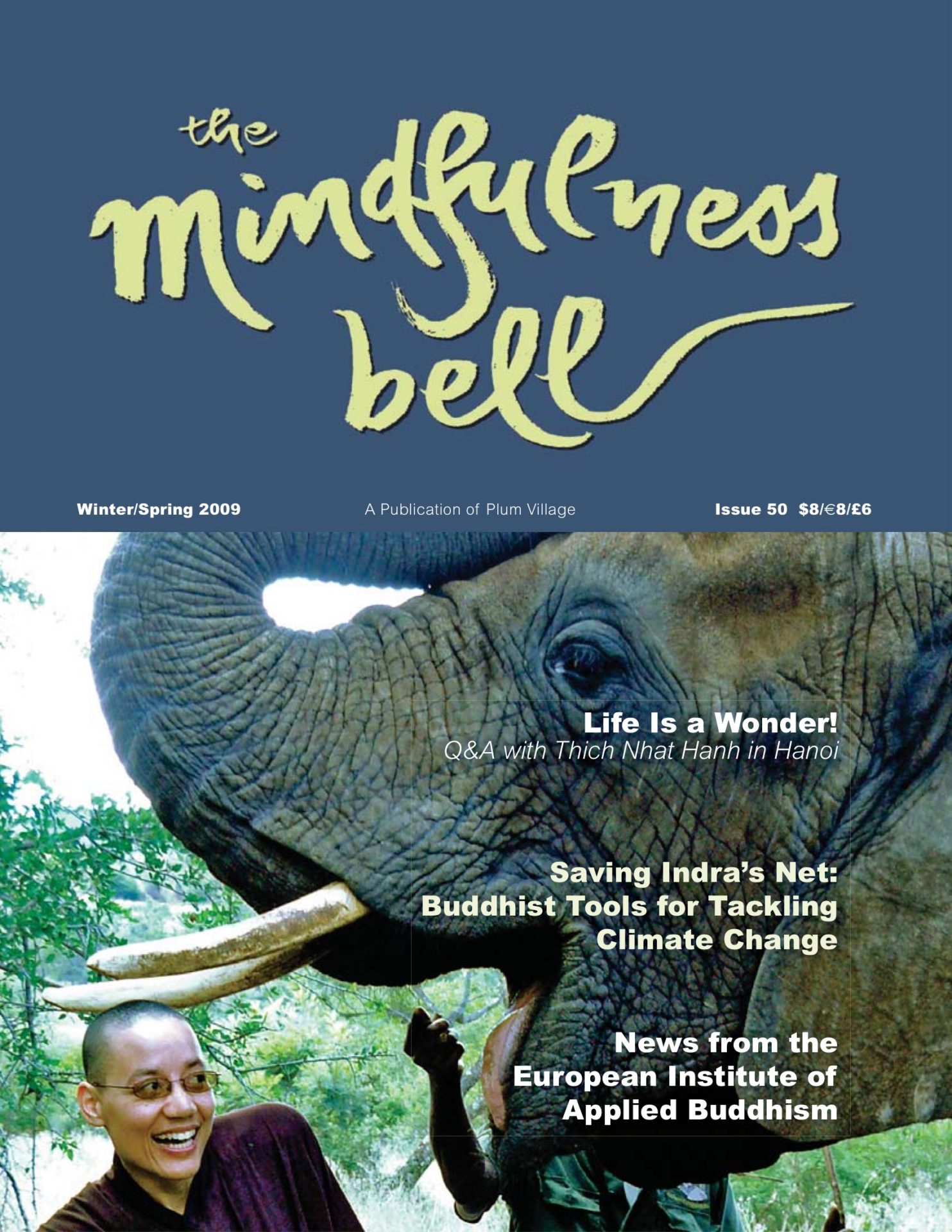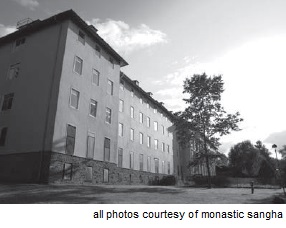
Buddhist Institute Opens in Germany
The European Institute of Applied Buddhism was opened in September 2008 in Waldbröl, Nordrhein-Westfalen, Germany. Thay’s first visit to the EIAB after it had been acquired by the Unified Buddhist Church was during the second week of September 2008. During this visit some monks and nuns came to stay in the building. There was no heat or hot water, and since the building had been uninhabited for two years,

Buddhist Institute Opens in Germany
The European Institute of Applied Buddhism was opened in September 2008 in Waldbröl, Nordrhein-Westfalen, Germany. Thay’s first visit to the EIAB after it had been acquired by the Unified Buddhist Church was during the second week of September 2008. During this visit some monks and nuns came to stay in the building. There was no heat or hot water, and since the building had been uninhabited for two years, there was a great deal of cleaning to be done. The Mayor of Waldbröl kindly offered the services of the town to clear up the grounds before an important press conference presided over by Thay.
The building was constructed in 1897. It was founded by a local philanthropist, a pastor and doctor from Cologne, Dr. Hollenberg, and three other doctors, for the treatment of the mentally ill whose families were too poor to pay for their treatment. Dr. Hollenberg was responsible for other philanthropic works in the town of Waldbröl and is remembered on the ancestral altar in the Institute. On 14 November 1938, 700 people were removed from Waldbröl, including some from this hospital; they were taken to unknown locations where their fate was uncertain.
Many were put to death by injection or sterilized by the Nazi regime. The hospital was turned into one of Hitler’s recreational centres. Since the fall of the Nazi regime the building has been a hospital and then a NATO military academy. The legacy of this building is one of philanthropy and compassion as well as ignorance and suffering.
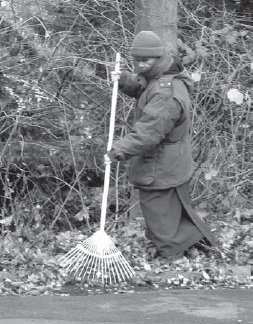
House of Transformation
The large building consists of 400 rooms on four floors. In September Thay visited each of these rooms and sprinkled each with consecrated water. He was accompanied by a number of monks and nuns who chanted the name of Avalokiteshvara. It took four hours to complete this ceremony. The aim of this visit was to begin the process of healing that the monastic residents of the Institute have been doing their best to continue ever since. Interestingly enough the house was called House of Transformation when it was a military academy and we are happy to keep that name. Our daily practice is to take every step in mindfulness and offer up the energy to heal the suffering that has happened here. The stairs are made of marble as is the main corridor of the ground floor. It seems strange for monks and nuns to be living in such luxurious surroundings but we know that the laying of these marble floors cost much sweat and hardship for many people and our steps respond with compassion to this.
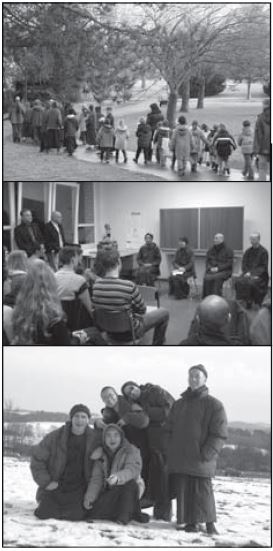
Thay visited us again in November and wrote a letter to be read to those who suffered here. This letter is read aloud every day before the sitting meditation and during the offering ceremony to the wandering spirits. [See sidebar page 42.] This offering ceremony is performed daily by the monks and nuns in residence. Its purpose is to give rise to compassion that is able to heal the legacy of suffering in this building that has still not been wholly transformed. Please be assured that we are very happy to play a part in doing this work of transformation and are grateful to have this privilege.
One day when we were gathered to sing before walking meditation in the grounds of the Institute Thay told us that we do not need to avoid hardship and difficulties. These things can be causes and conditions for us to solidify our practice of mindfulness, understanding, and compassion. They give us the motivation to take refuge in each other and do what Martin Luther King most wanted, build the Beloved Community.
In the town of Waldbröl we have the support of the Mayor and his deputy. We also have the support of the Catholic priest and Protestant pastor, who have invited the monks and nuns to their churches to speak to their congregations. The county construction committee has the duty to make sure that we bring the building up to date with the latest safety regulations. It seems that the military did not need to fulfill these requirements and so we have a great deal of expensive work to complete. Until this work is completed we are not allowed to receive overnight guests in the building. Fortunately right next to us is a school for conscientious objectors who are training in voluntary service and this school has beds for rent on the weekends. This means that we can organise weekend retreats.
Traveling With a Bag Full of Moon
When Thay visited us in November, many monks and nuns also came. They drove from Plum Village, stopping overnight in the Paris meditation centre La Maison de l’Inspir. Once everyone was here Thay led us on a wonderful walk around the grounds of the Institute. This included the beautiful apple orchard on a hill with wide views and the local park just below the front of the Institute. Thay pointed out that the feng shui of the building is good, with the high mountains lying behind and the valley in front. We were delighted to find three bushes still in fragrant flower amidst the falling golden leaves.
The next morning the full moon was in the early-morning sky and a bell at 5:30 invited us to full moon meditation. There is a court at the top of the steps that is the perfect place to see the full moon. At first the sky was clear and we saw that bright reflection of the sun’s light. Then clouds came and we saw the moon go into her room but the radiance still came through its walls. In freedom she came in and out of the clouds. After twenty minutes outside we came into the building and sat in the hall where Thay had given the press conference in September. We watched the moon through the large windows. Then Thay spoke about poems describing the moon. We heard an explanation of the Vietnamese expression, “traveling with a bag full of moon.” This refers to someone like Thay Giac Thanh who needed few material things because he had plenty of freedom to enjoy the wonderful and beautiful things in life.
On the weekend a public talk and Day of Mindfulness were given for the people of Waldbröl. For this the auditorium of the neighbouring hospital was rented. Over three hundred people attended, including Sangha friends from Holland.
Thay gave warm and inclusive teachings on mindfulness and the non-sectarian nature of Buddhist practice. The mindfulness day began at 5:30 with walking meditation to the auditorium while it was still dark. This was followed by sitting meditation, breakfast, and then a Dharma talk on the Four Mantras and how we can deal with our angry feelings. We had walking meditation in the park below the Institute and sat for a while together.
Future Retreats
We are now practicing the three-month winter retreat. Our doors are open for the local people to come and join us for walking and sitting meditation as well as two mindfulness days every week. We have an overnight retreat at the end of each month and go to the library to lead a two-hour session in basic mindfulness every week. Local people express their appreciation of the peace and joy they feel when they are with us.
After the winter retreat we shall be organising more retreats. The Dutch Sanghas have already asked to organise a retreat for them on Buddhist psychology at the Institute.
Please let us know if you would like a retreat for your Sangha. Our e-mail address is eiabmcampus@gmail.com.
—Sister Annabel, True Virtue

For the 700 people taken from their home on 14 Nov. 1938
Dear friends, dear children,
Seventy years ago, you were treated badly. They took you from your home and forced you into camps, they sterilized you so that you wouldn't have a continuation, and they killed many of you through euthanasia. The was enormous. Not many people were aware of what was happening to you. You have suffered from that time on.
Now the Sangha has come, the Sangha has heard and understood your suffering and the injustice you endured. The Sangha has practiced mindful walking, sitting, breathing, and chanting. The Sangha has asked the Buddhas, Bodhisattvas, Patriarchs, and other great beings to transfer to you their merits and their freedom, so that you have a chance to be released from ten injustice you suffered and remanifest in beautiful new forms of life. The people who caused your suffering have also suffered a lot. They did not know what they were doing at that time. So please allow compassion and forgiveness to be born in your heart so that they also can have a chance to transform and heal. Please support the Sangha and the next many generations of practitioners so that we can transform these places of suffering into places of transformation and healing, not only for Waldbrol but for the whole country of Germany and the world.

A Report on the India Trip
The trip was divided into three parts: three nights each in Varanasi, Bodh Gaya, and Rajgir. We traveled in 11 buses with about 300 participants and 30 monastics. The trip was very well organized. Each bus was designated a number and color, and everyone got a cloth bag matching their bus color. Each group stuck together throughout the trip, staying in the same hotel, eating together, and meeting to exchange how the trip was going.
Varanasi
On October 20 we checked into our respective hotels in Varanasi, had lunch there, and went to the Tibetan Institute in Sarnath for a general introduction. The Tibetan Institute served as our home base for three days and is where the monastics stayed. On October 21 we visited the Sarnath Museum and had lunch at the Tibetan Institute. That afternoon Thich Nhat Hanh gave a public talk at Deer Park in Sarnath. Everyone sat in the shade of the Dhamekh Stupa, which commemorates where the Buddha gave his first teachings. Many monks from Sarnath were in attendance. Afterwards Thay led walking meditation around the ruins of the site, lasting long past sunset, so that we were walking much of the time in almost total darkness. The next morning, in 11 rented boats, we watched the sun rise over the Ganga while drifting slowly downstream. Even Thay came for the boat ride! That day we returned to the Tibetan Institute for lunch and for Thay’s lecture to teachers who had been invited from the area.
Bodh Gaya
At 9:00 a.m. on the 23rd we boarded buses for the long ride to Bodh Gaya, where we arrived shortly before dinner. On the 24th we spent the day at the Mahabodhi tree temple for a public Day of Mindfulness, which was accompanied by some official fanfare (many children in uniforms, lots of lotus flowers). Thay gave a public speech attended by quite a number of people, including a large group of female teachers and a large group of monks. The Mahabhodi Society hosted everyone for lunch. Afterwards, Sister Chan Khong offered a session of Deep Relaxation and Touching the Earth. Shantum Seth (who organized the trip) led a tour of the temple grounds. The day ended with a candlelight procession, with the entire group doing walking meditation around the temple at three different levels successively. This was quite moving and beautiful.
On the 25th, we visited Sujata village across the Neranjara river, with a view of the Bodh Gaya temple. Sujata was the young girl who found Siddhartha at the end of his most ascetic phase and offered him food daily. A podium had been prepared under a large bodhi tree, and Thay spoke about Siddhartha’s experiences in the area. We were offered warm Kheer in bowls made of sal leaves. This is what Sujata had to offer Siddhartha on the first day she met him. The Ahimsa foundation (organizing the trip) has bought a plot of land here, where Thay planted four trees. Then we walked through the village, arousing quite a bit of curiosity. We spent time near the large stupa that commemorates Sujata, enjoying the view of mountains and rice fields — much like scenery in Vietnam! Lunch again at the Mahabodhi Society and an afternoon off. Some people visited the various Buddhist temples in Bodh Gaya.
Rajgir
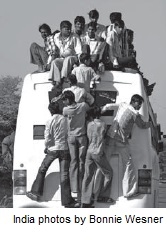
On Sunday October 26 we departed Bodh Gaya at 8:00 a.m. headed for Rajgir in a caravan of 11 buses. The route we took was very rough and bumpy. Most of the way we traveled along one-lane dirt roads. The scenery was beautiful. Occasionally we wound through small enclaves of houses, not even villages, really. Children ran towards the buses waving their arms in great excitement, and women stopped their work to stare at the passing parade of buses filled with foreigners. I never figured out why we took this route. Were no larger roads available or convenient? Or did someone decide we should travel along the kind of path which the Buddha would have taken between Bodh Gaya and Rajgir? Probably neither the scenery nor the way of life has changed that much since then.
Late in the afternoon, we arrived in Rajgir and checked into our “hotels” in a rather strange complex housing a former (and future?) munitions factory. The whole scene was a bit unsettling – many modern buildings, all several stories high and empty, no people in sight anywhere, lots of power lines between us and the view of the mountains. But the three nights we spent there were good ones. Shortly after arriving at the hotel, we headed off to Gridhakuta Mountain. Vulture Peak there was one of the Buddha’s favorite places. He and his main disciples are said to have had huts up there. King Bimbisara, the Buddha’s first wealthy patron, built a path up to Vulture Peak and donated land nearby for the Buddha’s first monastery, Bamboo Grove Monastery. We assembled at the start of this brick path and followed Thay up the mountain. There we watched the sun set, the monastics chanted quietly, and we walked back down in silence.
The next morning we all left at 5:00 for Bamboo Grove. This was a wonderful morning. The park was beautiful, the atmosphere very special. Thay led walking and sitting meditation. After breakfast, we headed to Nalanda University where Thay received an honorary doctorate and gave a speech — perfect speech. He described, among other things, how Buddhism can help restore communication in families and communities. He urged Buddhist scholars not to indulge excessively in intellectual debate. Instead they should make Buddhist teachings simple and applicable to daily life. Only in this way can interest in Buddhism be revived in India, the goal of the Nava Nalanda Mahavira. An elegant buffet lunch was served and then we visited the ruins of the ancient Buddhist site of learning. In the evening those who wished to could return to Bamboo Grove.

On the next day we departed before dawn for Gridhakuta Mountain. We walked up the brick path in complete darkness, carefully winding around cows lying or standing along the way, for sunrise meditation. Then Thay made some comments on a portable loudspeaker. We are lucky, he said, that we can enjoy the same sunset, the same vegetation, the same landscape as the Buddha did here. We can also look at this all with “Buddha eyes.” Later that morning Thay led the transmission ceremony for the Five Mindfulness Trainings. I had a view of the beautiful setting from above: to the left and right I could see green hills and trees; in the center was a kind of amphitheater formed by huge boulders where the monastics were seated, dressed in their yellow ceremonial robes. Afterwards we were free to spend the whole day up there together as we liked: in silence, in quiet mindful speech, meditating, or exploring about. I talked with friends, napped in the shade of a big rock, picked up some trash.
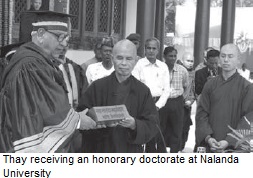
Late in the day we assembled again to watch the sunset. A small Japanese group carried out their own ceremony in front of the makeshift “altar” on Vulture peak. Our group just sat in silence. After they had finished taking pictures, we watched the sun set in silence and then walked back down the mountain, also in silence. While descending, Thay turned around several times to look at the departing scenery. One time he turned around and bowed. Later we realized that this was his goodbye. That evening there was an elaborate buffet dinner for Diwali and a musical performance sponsored by the state of Bihar. The next morning buses left in several shifts to Patna, according to when people had flights and trains. After a day-long ride to Patna, we checked into a hotel for one night before our own flight to Frankfurt via Delhi.
Reflections
A few times before and during the trip, I became a bit uncomfortable with the whole idea of a pilgrimage. But repeatedly Thay returned to a theme which addressed exactly this matter: urging us to get in touch with the Buddha inside ourselves. Especially at Bodh Gaya, many people were perfoming loud and elaborate ceremonies, perhaps intended to get them in touch with the Buddha, the Buddha outside of them, the God Buddha. But Thay kept encouraging us to look inwards: to think, speak, breathe, walk, and act mindfully. This is what he always teaches regardless whether the location is southern France, the Rocky Mountains in Colorado, or Buddhist sites in Northern India!
Sangha Mourns the Loss of Peter Kollock
Brother Phap De writes: “It is with deep sadness that I inform you of the death of Peter Kollock, UCLA professor, who was instrumental in developing the very successful College Student Retreats at Deer Park. Those of you who knew and worked with Peter found him to be our brother, friend, and teacher. He was an inspiration to his students and to professors from other universities, who followed his lead in taking the mindfulness practice into many universities.
“Peter was a very skillful and careful motorcycle rider. He had just said good-bye to his wife, Ellen, and, apparently, was on his way from Calabasas to UCLA. According to the police, Peter, was hit by a powerful cross wind, causing him to hit the curb. His body was catapulted into a tree, killing him instantly.
“Please keep Peter in your hearts, sending loving energy to him, Ellen, and family.”
Claire Venghiattis, Great Courage of the Heart, lives in Mannheim, Germany.

